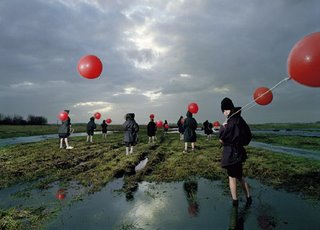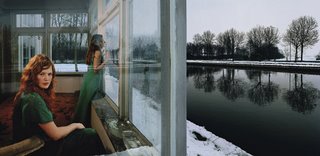 ELLEN KOOI
ELLEN KOOI
by Gigliola Foschi for Zoom Magazine
In the large-scale images of Dutch photographer Ellen Kooi we are offered the hazy landscapes of the Netherlands with its flat, wet fields that stretch as far as the eye can see, the streams that flow calmly between verdant banks and the wooded areas with their neatly-planted rows of trees. In these tranquil settings, laced through with a foggy and vaguely melancholic atmosphere, there occur minute events that are both mysterious and playful, but which subtly—and even willfully—mar this orderly pastoral calm. It is as if in the photographs of Ellen Kooi there were always something going on behind the scenes: something ambiguous, some split, that causes us to oscillate between enchantment and madness, or amusement and uneasiness.
A youth runs at breakneck speed through the frozen countryside, at the center of which is a surreal wooded grove illuminated by the rays of the sun ("Halfweg", 2003). A long, orderly line of people emerge from the waters of the Ijsselmeer (the inland sea to the north of Amsterdam) and then, silently lost in thought, make the climb up the green knoll ("Schellinkhout", 2000). We also meet a group of children who, just like a brightly-colored flock of birds, perch and cling to tree trunks in the woods. We also see other children making their way across a muddy field, each with a shiny red balloon in-hand, as well as a child who arches his body across the two sides of a stream, as if to form a suspension bridge. Sometimes one is tempted to think that all these children are having fun bringing to life somewhat gloomy fairy tales, while other times we suspect that they are trying to commit small, almost senseless acts just to get at our adult rationality. Other times, however, these youngsters just observe us looking out from solitary gazes that seem rooted in some enigmatic distance.
While it is true that all these children and adolescents are caught up in play, their games often have something insane and aimless about them that sets aside the rules of reality and causes us to drift about, lost. They are young people that become mute, solitary presences, yet a sort of silent scream, a call of alarm, reaches us from them. Ellen Kooi always succeeds in introducing into her images something that causes unease and disorientation with respect to ourselves and what we see. It is as if some disparity, some difference within the scene caused the identity of what is real—the relationship of every object to itself—to become unstable, thus causing the reassuring experience of what is familiar and recognizable to slip away towards a disturbing sense of being lost and estranged. But it is a sense of extraneousness which in some obscure way also involves us and which we feel is woven into our own experience. In fact, the images of this photographer are striking not so much because they bring to the fore a sort of surreal theater of the absurd, but because they open small windows onto what is different within us, onto those memories we have cancelled due to the reassuring need for normality and onto our innermost contradictions.
Like many other contemporary photographers, Ellen Kooi constructs these disarming situations just as a director would. Then, subsequently, she accentuates the effect of estrangement and unreality through computer editing. Her preference for skilfully-orchestrated settings which she balances on a razor’s edge between normality and senselessness and playfulness and perturbation, is perhaps the result of her love of the theater where she began her photographic career. On the other hand, in her tendency to compose images in which symbolic, real and surreal elements are interwoven, she is much like other Dutch artists, such as Teun Hocks. Hocks, however, utilizes painting and photography to create Magritte-like situations with a provokative and fiercely humorous standpoint. The works of Ellen Kooi (who will be showing at the Les Filles du Calvaire gallery in Paris in April and at the PPOW in New York in October) seem to be interlaced with a subtle sense of suspense, as if cloaked in an undefinable, immobile and padded silence.
As in Hitchcock’s work, the low point-of-view she uses forces the viewer to look at the scene from ground level. This creates in the observer the impression of intruding within a different world, like Alice in Wonderland. The suspended unreality of the setting is further underscored by both the crystalline colors of the photographs as well as a strange cold light that seems to be emanating from some other magical place. Her frequent use of panoramic format for photographs that are further given a mirror-like finish by plexiglas is confirmation of her cinematographic viewpoint. But, at the same time, because we are faced with still photography images and not moving film, this movie-like vision is trapped within a paradoxical time frame suspended between some unknown past and a future that cannot be grasped.
As the critic Martine Schneider-Speller has written: "Departing from a perfect location for narrations where fairy tales, thrillers, psychosis, burlesque, nature and men are all interconnected, she creates worlds that echo in our eyes. These works enhance that history is everywhere but its center nowhere. Fragility, hidden actions on impulse, silent ongoing movements within and without time are the connecting thread across this work." It is as if each one of her photographs contains a sort of imbalance that damages our ability to identify, but at the same time draws us into a world suspended between dream and reality, opening onto a dark other-world.
 © 2006 Ellen Kooi.
© 2006 Ellen Kooi.
All Photographs By Ellen Kooi. All rights reserved.
Courtesy Torch Gallery Amsterdam, Les Filles du Calvaire, Paris.
Thank you Ellen for giving me the possibility to have your work on my Blog!
Nadja

No comments:
Post a Comment